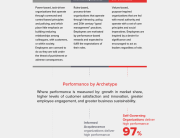Harvard Business Review’s article, “Storytelling That Moves People” , has resurfaced again recently. Though it’s been over 10 years since it was first published, I’m struck by its still very relevant message and how eloquently interview subject, writer and director Robert McKee, describes both the components and power of a good story as well as the qualities of a good storyteller. Organizations are desperately in need of both. Employee engagement depends on it.
I found it very telling that the article attributed the skill of storytelling to a characteristic corporate organizations often struggle with demonstrating – humanity:
“The more you understand your own humanity, the more you can appreciate the humanity of others in all their good-versus-evil struggles.”
Moving people requires lighting an emotional fire under them. Mission statements, presentations and Town Halls in and of themselves don’t inspire people to trust you, go the extra mile, change their way of thinking or BEHAVING or push through a difficult time for the sake of the company. Especially if they’re not anchored to a central purpose or demonstrated with any regularity.
Any one of the following common sins drives a wedge between leadership and the employee population. Committing them hinders the personal – human – connection your employees could have to your company. How many are you guilty of?
1. Not living up to your mission – Sure it’s on a plaque… somewhere, or hidden on your website but unless the organization (ie Leadership) demonstrates it – everyday – then there’s no reason for your employees to believe in it or work for it either.
2. Masking the truth – This is a big one. Ironically, some organizations do this in the name of preserving morale. As if your employees can’t read the writing on the four walls that surround them. Even worse, they could misinterpret that writing. Save yourself some time and energy and needless attrition – be transparent.
3. Diluting the struggle – Lukewarm problem statements result in lukewarm effort. Letting employees in on the nature of the struggle, gives them license to help you overcome it and allows them to celebrate in that achievement.
4. Hiding behind emotionless rhetoric – You manage to communicate change or updates to your team, but do you share why these changes are important? Necessary to preserving competitive advantage? Survival? If not, these gatherings hold little value.
5. Failing to investigate / follow up on employee challenges – When was the last time you took an employee survey? Acted on its results? The most obvious means by which to show an interest in employee engagement is to do just that – engage. Study after study tells us that finding out what your employees think, is important to your bottom line. It’s also key to keeping you competitive.




























